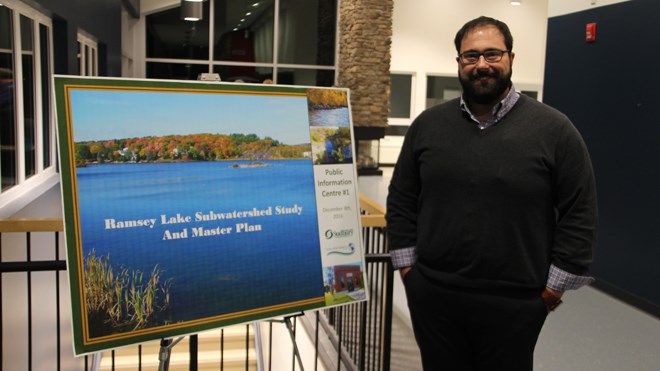The City of Greater Sudbury is moving forward with a study of water quality in Ramsey Lake through a provincially funded subwatershed study.
This is the first of nine studies that the Ontario government is funding, and is expected to be completed by March, 2018.
Ramsey Lake serves as a drinking water source to roughly 40 per cent of Sudburians, with the other 60 per cent coming from the Wahnapitae River.
The study is being carried out by Aquafor Beach and looks at everything from stormwater entering the lake to the historical industrial impacts of mining on the lake, to impacts of development around Ramsey Lake.
"Ramsey Lake is a recreational jewel in the city of Greater Sudbury," said Paul Javor, drainage engineer, City of Greater Sudbury. "Not only is it a major asset to the community but it's also a key drinking water source."
The city held a public meeting Dec. 8 at the Northern Watersports Centre to give residents a status update as far as where the study is at present and what is being looked at.
"It's very early in the study and this is our first point of public contact," said Javor. "This study is specifically for Ramsey Lake and we have two others (Junction Creek, White Water Lake in Azilda) that are in the tendering process right now. We're looking at the overall health of the watershed, the natural heritage component - so the land, the lake, the fish - the ultimate goal is, how do we get to have a healthier lake, specifically looking at storm water controls. How do we control the water when it rains or when (snow) melts?"
An annual summer occurrence in Ramsey Lake is the presence of blue-green algae, and while this study isn't looking into the algae in specific, Javor says that the contents of the water that cause the algae are being studied.
"We're looking at the various nutrients that lead to blue-green algae...the phosphorus, nitrogen and we're looking at the existing data sets and trends and how we can make improvements into the existing system," said Javor.
"The other big takeaway from the study is new criteria for new development...so increasing the requirements for new development. We want less water coming off their site and better quality of water coming off their site. There will be new criteria to adhere to when you develop and that will lead to an improvement in water quality. There's a lot of fear that the lake can't handle new development, but if you do it responsibly with new criteria, you can responsibly develop around the lake."
In February, the Ministry of the Environment and Climate Change announced $2.3 million for the city for the nine studies. The city has also committed $250,000 a year.
Under the provincial funding agreement, the work must be completed by March 2018, although deadline extensions are possible depending on circumstances.
The City will be meeting with representatives from Aquafor Beach regularly, as well holding public meetings throughout the course of the study to keep Sudburians up to date on what's happening with their water.
Can't make it to a public meeting? Feedback may be submitted online at www.greatersudbury.ca/watershedstudy2016.
